Plot-Scale Runoff Generation and Sediment Loss on Different Forest and Other Land Floors at a Karst Yellow Soil Region in Southwest China
Abstract
:1. Introduction
2. Materials and Methods
2.1. Experimental Site Description
2.2. Methodological Approach
- (1)
- Experimental plots under natural rainfall data collection
- (2)
- Data Acquisition and Processing
- (3)
- Calculations and statistical analysis
3. Results
3.1. Rainfall and Rainfall-Runoff Events Characteristics
3.2. Plot Runoff Amounts and Sediment Concentration Characteristics
- (1)
- Surface runoff characteristics
- (2)
- Runoff sediment loss characteristics
3.3. SEM Analysis of the Effecting Factors
4. Discussion
4.1. Characteristics of Sediment Loss in Karst Region
4.2. Factors Influencing on Suface Runoff and Sediment Loss
5. Conclusions
- (1)
- The average annual rainfall of study area in 2015–2020 was 1207.7 mm and concentrated in April-October; combined with the high susceptibility to erosion of karst yellow soil, accelerated soil erosion threatens human societies. There were 139 rainfall-runoff events occurring in 2015–2020, mainly moderate rain and heavy rain events. Heavy rain contributed the most to the total rainfall erosivity R value because of its high frequency and long duration.
- (2)
- The observation results of 18 runoff plots in Yangjichong soil and water conservation monitoring station from 2015 to 2020 indicated under the same rain conditions, different water conservation forest and different platting patterns had greater influence on surface runoff generation and sediment loss. Under the same natural rainfall conditions, the mean SR generating from fallow land and cropland were 133.90 mm and 82.89 mm, respectively, which were much higher than other vegetation cover types. The mean SR of broadleaf forest, coniferous forest, mixed forest, orchard, and grassland were 17.37 mm, 25.88 mm, 21.56 mm, 37.37 mm, and 44.69 mm, respectively, which were 19.33%, 12.97%, 16.10%, 33.38%, and 27.65% of fallow land, respectively. The vegetation root system or dead fall of the plots with vegetation cover could well hold rainwater and reduce the surface runoff.
- (3)
- The highest mean RSC value was 3.32 kg·m−3 of fallow, which was significantly larger than that observed for most other plots. The RSC value of cropland was 1.39 kg·m−3 and much larger than other plots. The mean RSC value of grassland was the lowest, indicating the grassland could maintain the karst yellow soil well. The mean SLR values of fallow and cropland were also much higher than that of other forests and grasslands. The standard deviations of SCR and SLR indicated SCR and SLR of cropland and fallow floor also vary considerably under different rainfall conditions.
- (4)
- Structural equation modeling analysis showed the relevant parameters for discriminating model fitness was acceptable. SR generation at the plot scale was substantial linked directly with I30. The VC and ASW resulted in the highest indirect impact on SLR.
Author Contributions
Funding
Institutional Review Board Statement
Informed Consent Statement
Data Availability Statement
Conflicts of Interest
References
- Yuan, D.; Jiang, Y.; Shen, L.; Pu, J.; Xiao, Q. Modern Karstology; Science Press: Beijing, China, 2016. (In Chinese) [Google Scholar]
- Song, T.Q.; Peng, W.X.; Du, H.; Wang, K.L.; Zeng, F.P. Occurrence, spatial-temporal dynamics and regulation strategies of karst rocky desertification in south-west China. Acta Ecol. Sin. 2014, 34, 5328–5341. [Google Scholar]
- Hartmann, A.; Goldscheider, N.; Wagener, T.; Lange, J.; Weiler, M. Karst water resources in a changing world: Review of hydrological modeling approaches. Rev. Geophys. 2015, 52, 218–242. [Google Scholar] [CrossRef]
- Wang, S.; Yan, Y.; Fua, Z.; Chen, H. Rainfall-runoff characteristics and their threshold behaviors on a karst hillslope in a peak-cluster depression region. J. Hydrol. 2022, 605, 127370. [Google Scholar] [CrossRef]
- Sweeting, M.M. Karst in China: Its Geomorphology and Environment; Springer: Berlin/Heidelberg, Germany, 1995; pp. 1–5. [Google Scholar]
- Ford, D.C.; Williams, P.W. Karst Hydrology and Geomorphology; Chapman &Hall: London, UK, 2007; pp. 1–5. [Google Scholar]
- Wang, S.; Fu, Z.; Chen, H.; Nie, Y.; Xu, Q. Mechanisms of surface and subsurface runoff generation in subtropical soil epi-karst systems: Implications of rainfall simulation experiments on karst slope. J. Hydrol. 2020, 580, 124370. [Google Scholar] [CrossRef]
- Xiong, K.N. Remote Sensing-GIS Typical Study of Karst Desertification—The Example of Guizhou Province; Geological Press: Beijing, China, 2002; pp. 1–10. (In Chinese) [Google Scholar]
- Wang, S.J.; Li, Y.B.; Li, R.L. Karst Rocky Desertification: Formation Background, Evolution and Comprehensive Taming. Quat. Sci. 2003, 23, 657–666. (In Chinese) [Google Scholar]
- Wilcox, B.P.; Taucer, P.I.; Munster, C.L.; Owens, M.K.; Mohanty, B.P.; Sorenson, J.R.; Bazan, R. Subsurface stormflow is important in semiarid karst shrub lands. Geophys. Res. Lett. 2008, 35, L10403. [Google Scholar] [CrossRef] [Green Version]
- Anache, J.A.A.; Wendland, E.C.; Oliveira, P.T.S.; Flanagan, D.C.; Nearing, M.A. Runoff and soil erosion plot-scale studies under natural rainfall: A meta-analysis of the Brazilian experience. Catena 2017, 152, 29–39. [Google Scholar]
- Tsozué, D.; Nghonda, J.P.; Mekem, D.L. Impact of land management system on crop yields and soil fertility in Cameroon. Solid Earth 2015, 6, 1087–1101. [Google Scholar] [CrossRef] [Green Version]
- Nyssen, J.; Frankl, A.; Zenebe, A.; Poesen, J.; Deckers, J. Environmental conservation for food production and sustainable livelihood in Tropical Africa. Land. Degrad. Dev. 2015, 26, 629–631. [Google Scholar] [CrossRef]
- Tesfaye, M.A.; Bravo-Oviedo, A.; Bravo, F.; Kidane, B.; Bekele, K.; Sertse, D. Selection of tree species and soil management for simultaneous fuelwood production and soil rehabilitation in the Ethiopian central highlands. Land Degrad. Dev. 2015, 26, 665–679. [Google Scholar] [CrossRef]
- Oliveira, S.P.; Lacerda, N.B.; Blum, S.C.; Escobar, M.E.O.; Oliveira, T.S. Organic carbon and nitrogen stocks in soils of Northeastern Brazil converted to irrigated agriculture. Land. Degrad. Dev. 2015, 26, 9–21. [Google Scholar] [CrossRef]
- Oliveira, P.T.S.; Nearing, M.A.; Wendland, E. Orders of magnitude increase in soil erosion associated with land use change from native to cultivated vegetation in a Brazilian savannah environment. Earth Surf. Process. Landf. 2015, 40, 1524–1532. [Google Scholar] [CrossRef]
- García-Ruiz, J.M.; Beguería, S.; Nadal-Romero, E.; González-Hidalgo, J.C.; Lana-Renault, N.; Sanjuán, Y. A meta-analysis of soil erosion rates across the world. Geomorphology 2015, 239, 160–173. [Google Scholar] [CrossRef]
- Guo, Q.; Hao, Y.; Liu, B. Rates of soil erosion in China: A study based on runoff plot data. Catena 2015, 124, 68–76. [Google Scholar] [CrossRef]
- Wischmeier, W.H.; Smith, D.D. Rainfall energy and its relationship to soil loss. EOS Trans. Am. Geophys. Union 1958, 39, 285–291. [Google Scholar] [CrossRef]
- Hartantoa, H.; Prabhub, R.; Widayatc, A.S.E.; Asdak, C. Factors affecting runoff and soil erosion: Plot-level soil loss monitoring for assessing sustainability of forest management. For. Ecol. Manag. 2003, 180, 361–374. [Google Scholar] [CrossRef]
- Li, X.-Y.; Contreras, S.; Solé-Benet, A.; Cantón, Y.; Domingo, F.; Lázaro, R.; Lin, H.; van Wesemael, B.; Puigdefábregas, J. Controls of infiltration—runoff processes in Mediterranean karst rangelands in SE Spain. Catena 2011, 86, 98–109. [Google Scholar] [CrossRef] [Green Version]
- Kim, J.K.; Onda, Y.; Kim, M.S.; Yang, D.Y. Plot-scale study of surface runoff on well-covered forest floors under different canopy species. Quat. Int. 2014, 344, 75. [Google Scholar] [CrossRef]
- Miller, M.F. Waste through soil erosion. J. Am. Soc. Agron. 1926, 18, 153–160. [Google Scholar] [CrossRef]
- Wischmeier, W.H.; Smith, D.D. Predicting Rainfall Erosion Losses—A Guide to Conservation Planning; Agriculture Handbook; US Department of Agriculture: Washington, DC, USA, 1978. [Google Scholar]
- Ji, Q.-F.; Zhang, X.-Q.; Zhang, K.-L.; Yang, Y.; Yang, G.-X.; Gu, Z.-K. Runoff and sediment characteristics of slope land in karst areas of Guizhou Province. Res. Soil Water Conserv. 2012, 19, 1–5. (In Chinese) [Google Scholar]
- Zhou, Y.; Wei, T.-X.; Xie, J.-Q.; Shi, X.; Ge, G.-B.; Dong, Z.; Cheng, Z.-Q. Different types of vegetation cover and water conservation benefits. J. Soil Water Conserv. 2012, 19, 12–16. (In Chinese) [Google Scholar]
- Lv, Y.-J.; Peng, X.-H.; Gao, L.; Zhang, Z.-B. Characteristics of runoff and soil loss and their influential factors on sloping land in red soil hilly region. J. Soil Water Conserv. 2014, 28, 19–23, 51. (In Chinese) [Google Scholar]
- Wischmeier, W.H.; Smith, D.D. Predicting Rainfall Erosion Losses from Cropland East of the Rocky Mountains; Agriculture Handbook; US Department of Agriculture: Washington, DC, USA, 1965. [Google Scholar]
- Renard, K.G.; Foster, G.R.; Weesies, G.A.; Mccool, D.K.; Yoder, D.C. Predicting Soil Erosion by Water: A Guide to Conservation Planning with the Revised Universal Soil Loss Equation (RUSLE); Agriculture Handbook; USDA: Washington, DC, USA, 1997; p. 703. [Google Scholar]
- Goblin, A.; Jones, R.; Kirkby, M.; Campling, P.; Govers, G.; Kosmas, C.; Gentile, R.A. Indicators for pan-European assessment and monitoring of soil erosion by water. Environ. Sci. Pol. 2004, 7, 25–38. [Google Scholar] [CrossRef]
- Cerdan, O.; Govers, G.; Le Bissonnais, Y.; Van Oost, K.; Poesen, J.; Saby, N.; Gobin, A.; Vacca, A.; Quinton, J.; Auerswald, K.; et al. Rates and spatial variations of soil erosion in Europe: A study based on erosion plot data. Geomorphology 2010, 122, 167–177. [Google Scholar] [CrossRef]
- Roose, E.J. Use of the Universal Soil Loss Equation to Predict Erosion in West Africa. In Proceedings of the Soil Erosion: Prediction and Control, West Lafayette, IN, USA, 23–28 May 1999. [Google Scholar]
- Stocking, M.A. Rates of erosion and sediment yield in the African environment. In Challenges in African Hydrology and Water Resources; Walling, D.E., Foster, S.S.D., Wurzel, P., Eds.; International Association of Scientific Hydrology (IASH-AIHS): Wallingford, UK, 1984; Volume 144, pp. 285–295. [Google Scholar]
- Lu, H.; Prosser, I.P.; Moran, C.J.; Gallant, J.C.; Priestley, G.; Stevenson, J.G. Predicting sheet wash and rill erosion over the Australian continent. Soil Res. 2003, 41, 1037–1062. [Google Scholar] [CrossRef]
- Liu, Y.B.; Xie, Y.; Zhang, K.L. Soil Erosion Prediction Model; Science Press: Beijing, China, 2001. (In Chinese) [Google Scholar]
- Huang, C.B.; Liu, Y.H.; Qin, W.M.; Wei, S.H.; Huang, D.; Li, B.P. Study on the water and soil erosion rules during the three types of vegetation recovery process. J. Nanjing For. Univ. 2010, 34, 59–64. (In Chinese) [Google Scholar]
- Guo, S.Y.; Li, Z.G. Development and achievements of soil and water conservation monitoring in China. Sci. Soil Water Conserv. 2009, 7, 19–24. (In Chinese) [Google Scholar]
- Zhang, X.K.; Xu, J.H.; Lu, X.Q.; Deng, Y.J.; Gao, D.W. A study on the soil loss equation in Heilongjiang Province. Bull. Soil Water Conserv. 1992, 12, 1–9. (In Chinese) [Google Scholar]
- Jiang, Z.S.; Wang, Z.Q.; Liu, Z. Quantitative Study on Spatial Variation of Soil Erosion in a Small Watershed in the Loess Hilly Region. J. Soil Eros. Soil Conserv. 1996, 2, 1–9. (In Chinese) [Google Scholar]
- Cai, Q.G.; Lu, Z.X.; Wang, G.P. Process-based soil erosion and sediment yield model in a small basin in the hilly loess region. Acta Geogr. Sin. 1996, 51, 108–117. (In Chinese) [Google Scholar]
- Liu, W.; Li, Z.; Zhu, J.; Xu, C.; Xu, X. Dominant factors controlling runoff coefficients in karst watersheds. J. Hydrol. 2020, 590, 125486. [Google Scholar] [CrossRef]
- Dieterich, M. Dynamics of a biotic parameters, solute removal and sediment retention in summer-dry headwater streams of western Oregon. Hydrobiologia 1998, 379, 1–15. [Google Scholar] [CrossRef]
- Duan, L.; Huang, M.; Zhang, L. Differences in hydrological responses for different vegetation types on a steep slope on the Loess Plateau, China. J. Hydrol. 2016, 537, 356–366. [Google Scholar] [CrossRef]
- Kou, X.Y.; Huang, J.; Jiang, X.B.; Xiang, J.P.; Jin, P.W.; Wang, S.W. Effects of Rainfall on Runoff and Sediment Under Different Underlying Surfaces of Runoff Plots. Bull. Soil Water Conserv. 2017, 37, 27–31. [Google Scholar]
- Zhao, Q.; Zhang, Y.; Xu, S.; Ji, X.; Wang, S.; Ding, S. Relationships between riparian vegetation pattern and the hydraulic characteristics of upslope runoff. Sustainability 2019, 11, 2966. [Google Scholar] [CrossRef] [Green Version]
- Hou, G.R.; Bi, H.X.; Huo, Y.M.; Wei, X.; Zhu, Y.; Wang, X.; Liao, W. Determining the optimal vegetation coverage for controlling soil erosion in Cynodon dactylon grassland in North China. J. Clean. Prod. 2020, 244, 118771. [Google Scholar] [CrossRef]
- Dai, H.L.; Yuan, S.; Zhang kl Zhu, Q. Spatial and temporal variation of rainfall erosion force in Guizhou Province. Res. Soil Water Conserv. 2013, 20, 37–41. (In Chinese) [Google Scholar]
- Li, Y.Q.; Deng, O.; Yang, G.B.; Fang, Q.B. Distribution Characteristics of Rainfall erosivity R Value in Yellow Soil Area of Central Guizhou Karst Mountainous Region. Bull. Soil Water Conserv. 2021, 41, 31–49. (In Chinese) [Google Scholar]
- Cai, X.F. Influencing Factors Analysis and Numerical Simulation on Erosion of Yellow Soil in Southwest Karst Area, China. Master’s Thesis, Guizhou Normal University, Guiyang, China, 2009. (In Chinese). [Google Scholar]
- Ping, Y.; Kangning, X.; Hengsong, W.; Jin, L.; Yang, L. Progress of Study on Soil and Water Loss and Soil and Water Conservation of Karst Region. Soil Water Conserv. China 2017, 1, 54–59. (In Chinese) [Google Scholar]
- Yang, Q.; Yang, G.B.; Zhao Qs Dai, L. Characteristics of runoff sediment yield on slopes under different rainfall and vegetation cover in karst areas. Bull. Soil Water Conserv. 2020, 40, 9–16. (In Chinese) [Google Scholar]
- Zhang, W.Y.; Wang, B.T.; Yang, G.X.; Zhang, K.L. Erosive Rainfall and Characteristics Analysis of Sediment Yield on Yellow Soil Area in Karst Mountainous. Ecol. Environ. Sci. 2014, 23, 1776–1782. (In Chinese) [Google Scholar]
- Liang, W.L.; Chan, M.C. Spatial and temporal variations in the effects of soil depth and topographic wetness index of bedrock topography on subsurface saturation generation in a steep natural forested headwater catchment. J. Hydrol. 2017, 546, 405–418. [Google Scholar] [CrossRef]
- Wischmeir, W.H. Estimating the Loss Equation’s Cover and Management Factor for Undisturbed Areas. In Proceedings of Sediment Yield Workshop; U.S. Department of Agriculture Sedimentation Laboratory: Oxford, MS, USA, 1972. [Google Scholar]
- Grace, J.B. The factors controlling species density in herbaceous plant communities: An assessment. Perspect. Plant Ecol. Evol. Syst. 1999, 2, 1–28. [Google Scholar] [CrossRef]
- Grace, J.B.; Anderson, T.M.; Smith, M.D.; Seabloom, E.; Andelman, S.J.; Meche, G.; Weiher, E.; Allain, L.K.; Jutila, H.; Sankaran, M.; et al. Does species diversity limit productivity in natural grassland communities? Ecol. Lett. 2007, 10, 680–689. [Google Scholar] [CrossRef] [PubMed] [Green Version]
- Riseng, C.M.; Wiley, M.J.; Black, R.W.; Munn, D.M. Impacts of agricultural land use on biological integrity: A causal analysis. Ecol. Appl. 2011, 21, 3128–3146. [Google Scholar] [CrossRef] [Green Version]
- Matías, L.; Castro, J.; Zamora, R. Effect of Simulated Climate Change on Soil Respiration in a Mediterranean-Type Ecosystem: Rainfall and Habitat Type are More Important than Temperature or the Soil Carbon Pool. Ecosystems 2012, 15, 299–310. [Google Scholar] [CrossRef]
- Mcleod, E.S.; Banerjee, E.W. Bork. Structural equation modeling reveals complex relationships in mixed forage swards. Crop Prot. 2015, 78, 106–113. [Google Scholar] [CrossRef]
- GB T 20486—2017; Inspection and Quarantine of the People’s Republic of China. Surface Rainfall Grade in River Basin. China Standards Press: Beijing, China, 2017.
- Parsons, A.J.; Brazier, R.E.; Wainwright, J.; Powell, D.M. Scale relationships in hillslope runoff and erosion. Earth Surf. Processes Landf. 2006, 31, 1384–1393. [Google Scholar] [CrossRef]
- Chai, Z.X. Soil erosion in karst area of Guangxi autonomous region. Mt. Res. 1989, 7, 255–259. [Google Scholar]
- Zhu, A.G.; Lin, C.H. The Synthetical Study on Elements of Loss of Water and Soil in Mountain Area; Guizhou Scientific and Technological Pressing: Guiyang, China, 1995; pp. 48–60. [Google Scholar]
- Chen, X.P. Research on characteristics of soil erosion in karst mountainous region environment. J. Soil Eros. Soil Water Conserv. 1997, 3, 31–36. [Google Scholar]
- Xu, Y.-Q.; Shao, X.-M. Estimation of soil erosion supported by G1S and RUSLE: A Study of Mao-tiao river watershed, Guizhou Provence. J. Beijing For. Univ. 2006, 28, 67–71. [Google Scholar]
- Zhiwei, Z.; Liwa, F.; Hong, Z. Study on soil erosion of diffrent degrees in karst region by using Cesium-137 technique. J. Mt. Sci. 2007, 25, 302–308. [Google Scholar]
- Zhan, C.S.; Jiang, S.S.; Sun, F.B.; Jia, Y.W.; Yue, W.F.; Niu, C.W. Quantitative contribution of climate change and human activities to runoff changes in the Wei river basin, China. Hydrol. Earth Syst. Sci. 2014, 11, 2149–2175. [Google Scholar] [CrossRef] [Green Version]
- Wei, L.; Dan, B.; Wang, F.; Fu, B.; Yan, J.; Shuai, W. Quantifying the impacts of climate change and ecological restoration on streamflow changes based on a budyko hydrological model in China’s loess plateau. Water Resour. Res. 2015, 51, 6500–6519. [Google Scholar]
- Xu, Y.; Wang, S.; Bai, X.; Shu, D.; Tian, Y. Runoff response to climate change and human activities in a typical karst watershed, SW China. PLoS ONE 2018, 13, e0193073. [Google Scholar] [CrossRef] [PubMed]
- Zhao, Y.; Zou, X.; Gao, J.; Xu, X.; Wang, C.; Tang, D. Quantifying the anthropogenic and climatic contributions to changes in water discharge and sediment load into the sea: A case study of the Yangtze river, China. Sci. Total Environ. 2015, 536, 803–812. [Google Scholar] [CrossRef]
- Cammeraat, E.L.H. Scale dependent thresholds in hydrological and erosion response of a semi-arid catchment in southeast Spain. Agric. Ecosyst. Environ. 2004, 104, 317–332. [Google Scholar] [CrossRef]
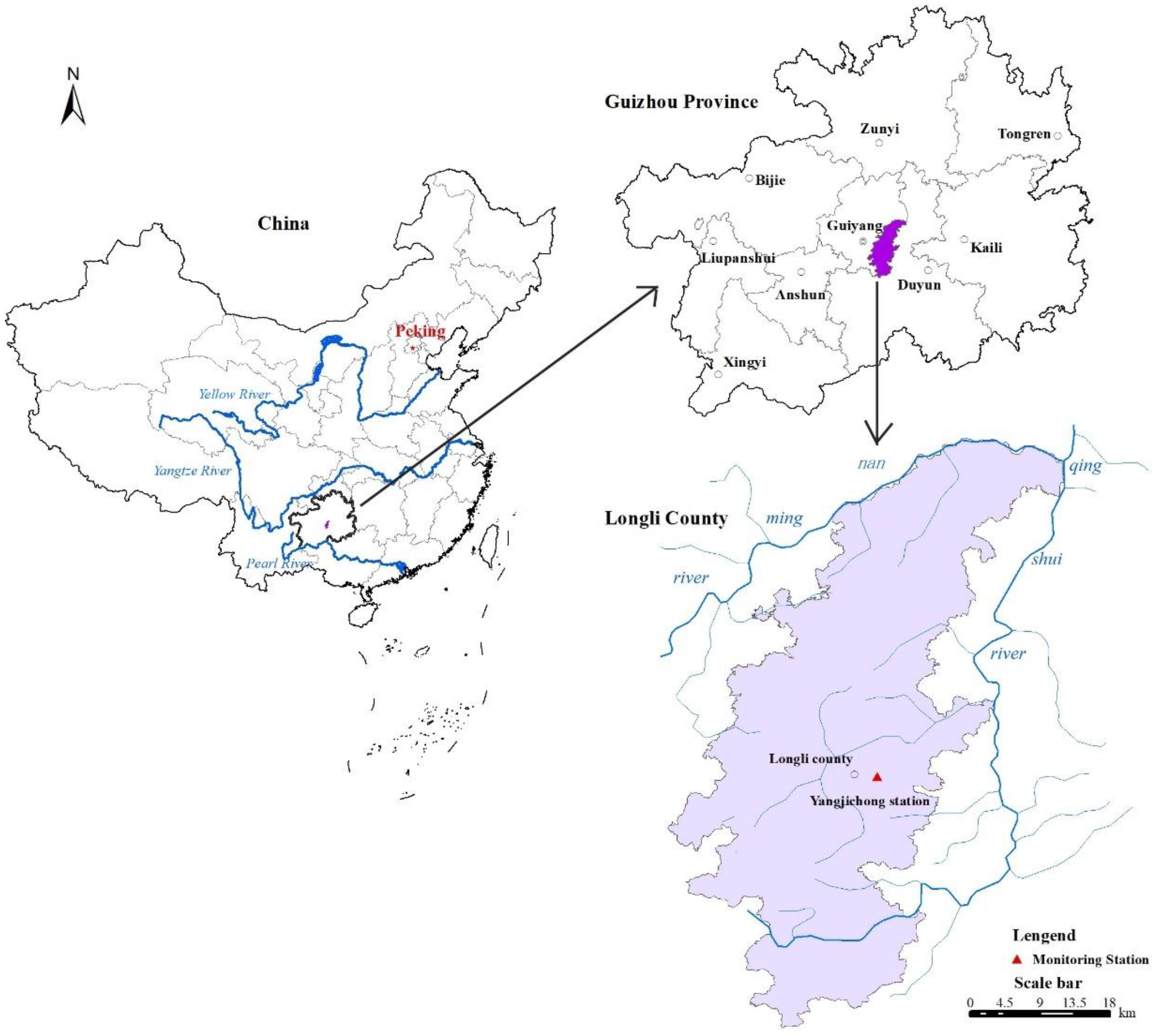
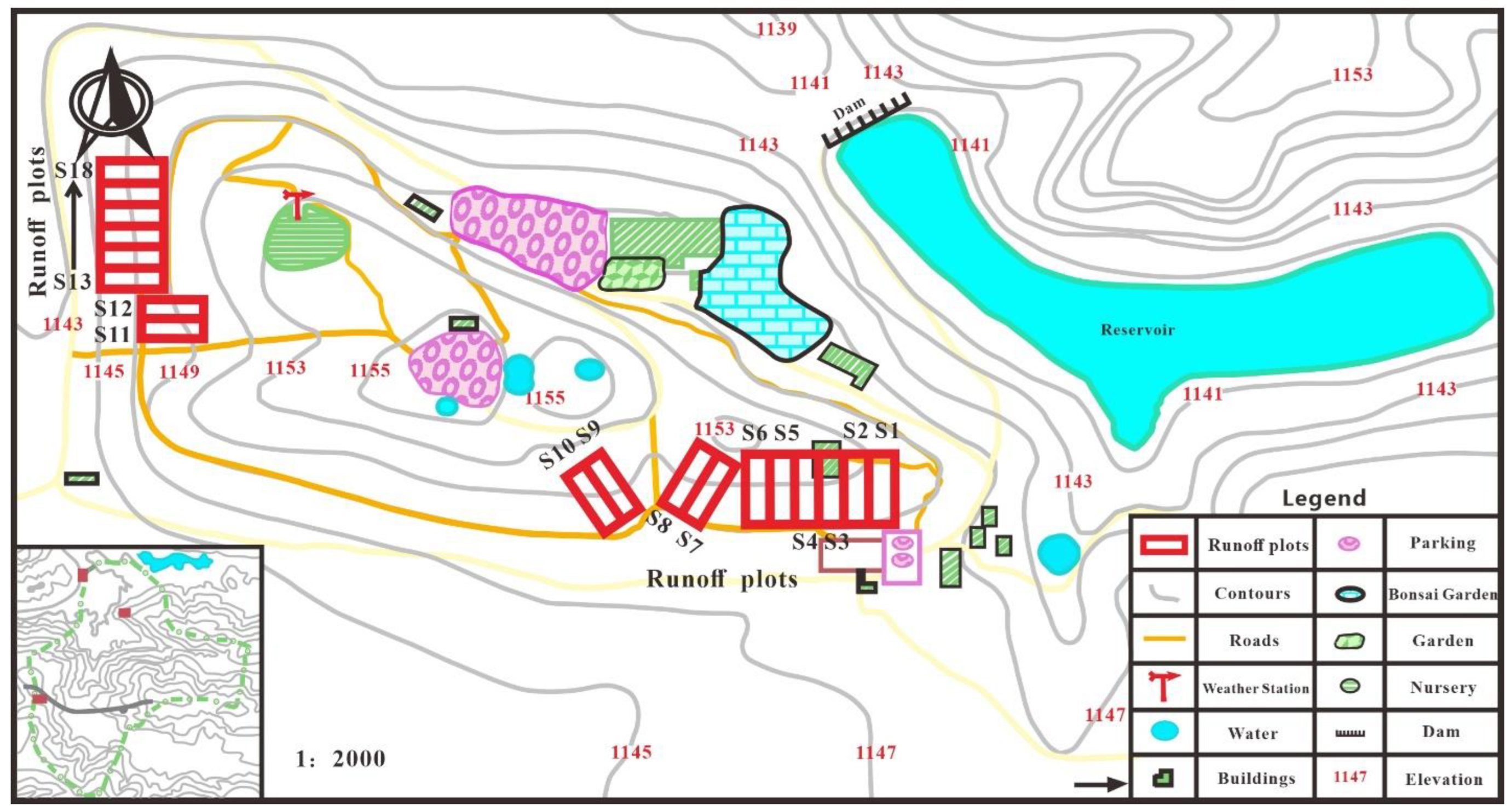
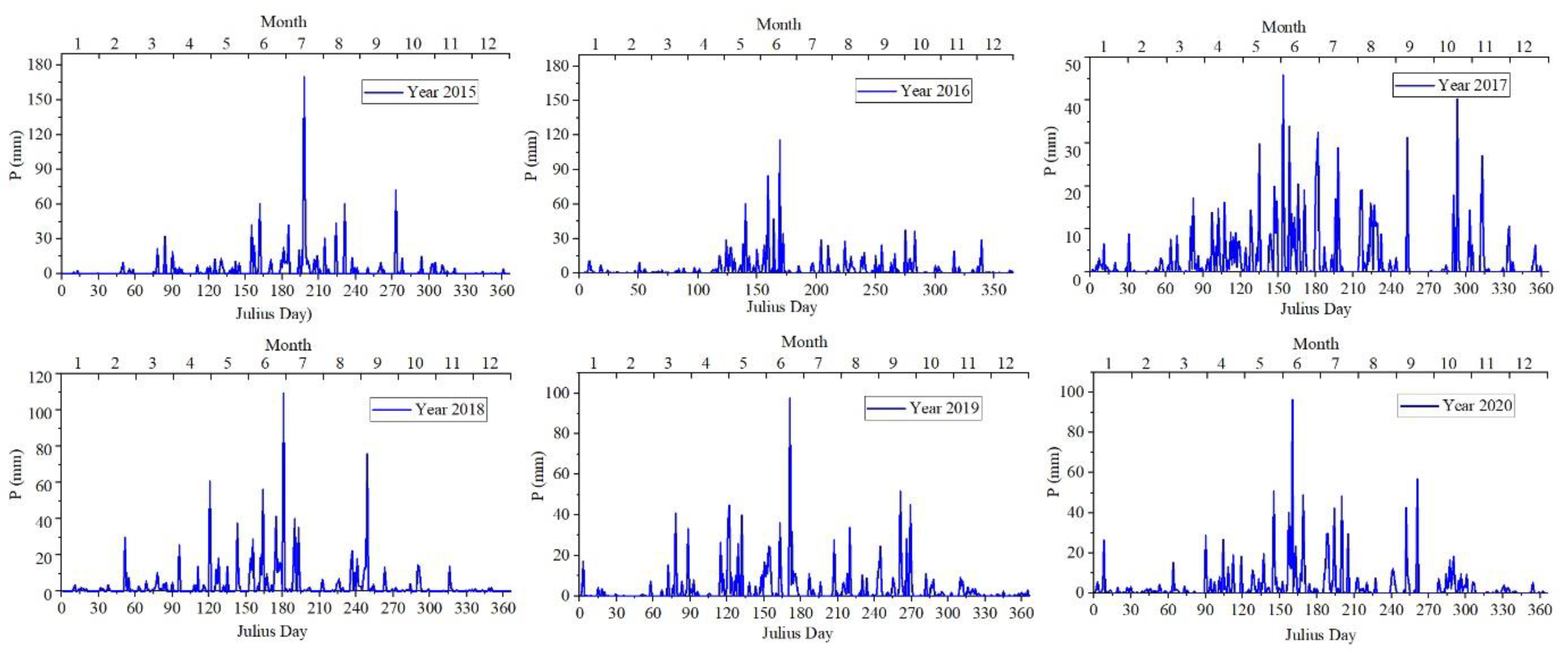


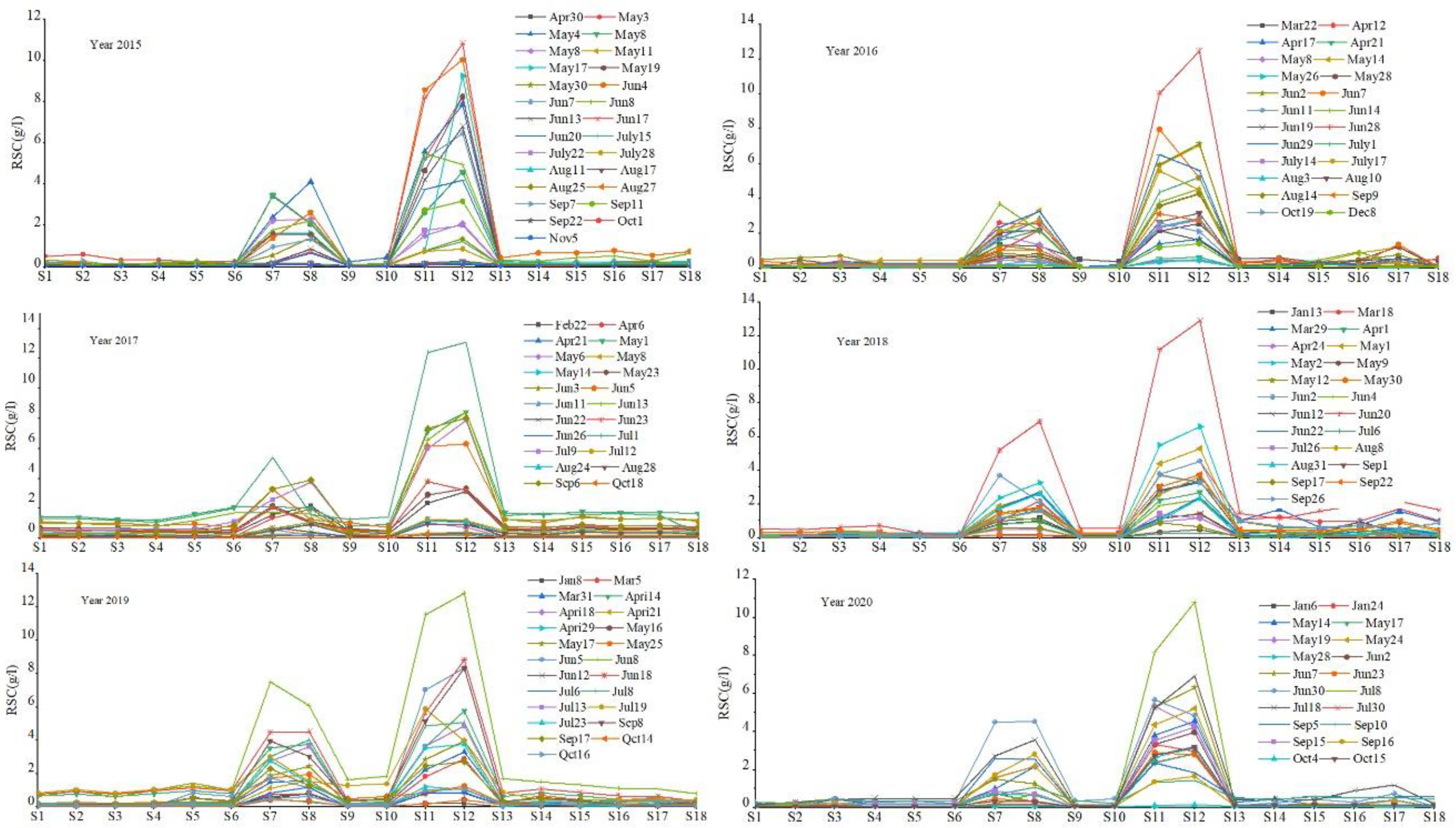
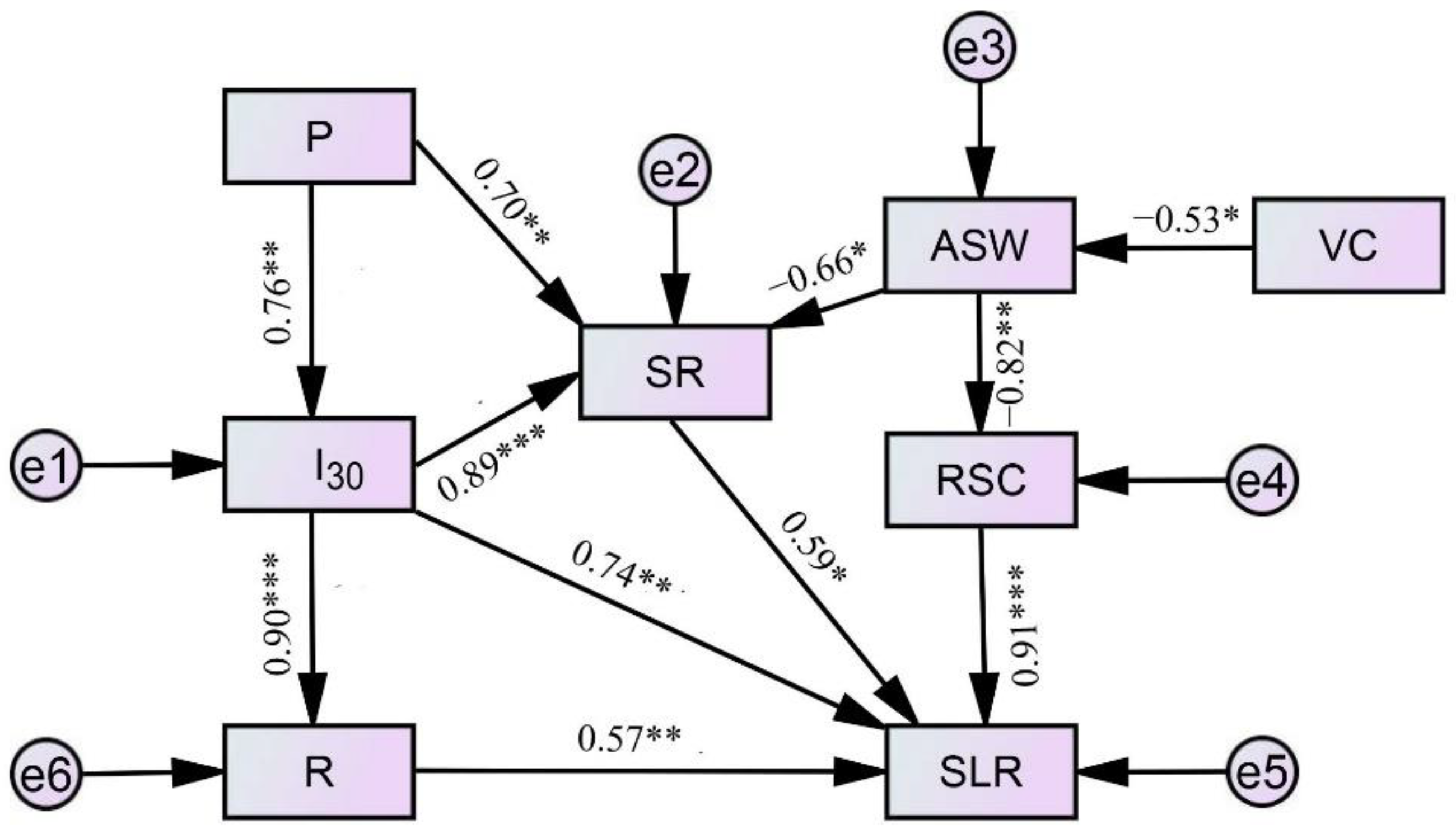
| Plots | Bedrock Types | Soil Types | Slope/Degree | Plot Size/Width × Length, m | Vegetation Types | Species |
|---|---|---|---|---|---|---|
| S1–S2 | Limestone | Yellow soil | 20.0 | 20.0 × 5.0 | Broadleaf forest | Poplar |
| S3–S4 | Limestone | Yellow soil | 20.0 | 20.0 × 5.0 | Coniferous forest | Cypress |
| S5–S6 | Limestone | Yellow soil | 20.0 | 20.0 × 5.0 | Mixed forest | Poplar and cypress |
| S7–S8 | Limestone | Yellow soil | 25.0 | 20.0 × 5.0 | Cropland | Corn, green vegetables |
| S9–S10 | Limestone | Yellow soil | 25.0 | 20.0 × 5.0 | Grassland | Natural meadow |
| S11–S12 | Limestone | Yellow soil | 25.0 | 20.0 × 5.0 | Fallow | bare |
| S13–S18 | Limestone | Yellow soil | 20.0 | 18.0 × 10.0 | Orchard | Waxberry, peach tree, pear tree, raspberry |
| Plots | Vegetation Types | SR (mm) | RC (%) | ||
|---|---|---|---|---|---|
| Mean | SD | Mean | SD | ||
| S1–S2 | Broad-leaved forest | 25.88 | 6.07 | 3.48 | 3.36 |
| S3–S4 | Coniferous forest | 17.37 | 6.48 | 2.31 | 7.63 |
| S5–S6 | Coniferous and broad-leaved mixed forest | 21.56 | 6.09 | 2.85 | 6.36 |
| S7–S8 | Cropland | 82.89 | 23.81 | 10.97 | 26.05 |
| S9–S10 | Grassland | 44.69 | 6.95 | 6.01 | 6.15 |
| S11–S12 | Fallow | 133.90 | 30.31 | 17.77 | 31.98 |
| S13–S18 | Orchard | 37.03 | 6.04 | 4.98 | 4.87 |
| Plots | Vegetation Types | RSC (kg·m−3) | SLR (t·ha−1·a−1) | ||
|---|---|---|---|---|---|
| Mean | SD | Mean | SD | ||
| S1–S2 | Broad-leaved forest | 0.14 | 0.13 | 1.62 | 2.03 |
| S3–S4 | Coniferous forest | 0.12 | 0.11 | 1.36 | 1.25 |
| S5–S6 | Coniferous & broad-leaved mixed forest | 0.13 | 0.16 | 1.49 | 2.13 |
| S7–S8 | Cropland | 1.39 | 0.35 | 12.64 | 6.76 |
| S9–S10 | Grassland | 0.16 | 0.12 | 1.85 | 1.08 |
| S11–S12 | Fallow | 3.32 | 0.41 | 23.49 | 9.26 |
| S13–S18 | Orchard | 0.29 | 0.18 | 2.97 | 3.24 |
Disclaimer/Publisher’s Note: The statements, opinions and data contained in all publications are solely those of the individual author(s) and contributor(s) and not of MDPI and/or the editor(s). MDPI and/or the editor(s) disclaim responsibility for any injury to people or property resulting from any ideas, methods, instructions or products referred to in the content. |
© 2022 by the authors. Licensee MDPI, Basel, Switzerland. This article is an open access article distributed under the terms and conditions of the Creative Commons Attribution (CC BY) license (https://creativecommons.org/licenses/by/4.0/).
Share and Cite
Peng, R.; Deng, H.; Li, R.; Li, Y.; Yang, G.; Deng, O. Plot-Scale Runoff Generation and Sediment Loss on Different Forest and Other Land Floors at a Karst Yellow Soil Region in Southwest China. Sustainability 2023, 15, 57. https://doi.org/10.3390/su15010057
Peng R, Deng H, Li R, Li Y, Yang G, Deng O. Plot-Scale Runoff Generation and Sediment Loss on Different Forest and Other Land Floors at a Karst Yellow Soil Region in Southwest China. Sustainability. 2023; 15(1):57. https://doi.org/10.3390/su15010057
Chicago/Turabian StylePeng, Ruiwen, Han Deng, Ruoshuang Li, Yiqiu Li, Guangbin Yang, and Ou Deng. 2023. "Plot-Scale Runoff Generation and Sediment Loss on Different Forest and Other Land Floors at a Karst Yellow Soil Region in Southwest China" Sustainability 15, no. 1: 57. https://doi.org/10.3390/su15010057
APA StylePeng, R., Deng, H., Li, R., Li, Y., Yang, G., & Deng, O. (2023). Plot-Scale Runoff Generation and Sediment Loss on Different Forest and Other Land Floors at a Karst Yellow Soil Region in Southwest China. Sustainability, 15(1), 57. https://doi.org/10.3390/su15010057






